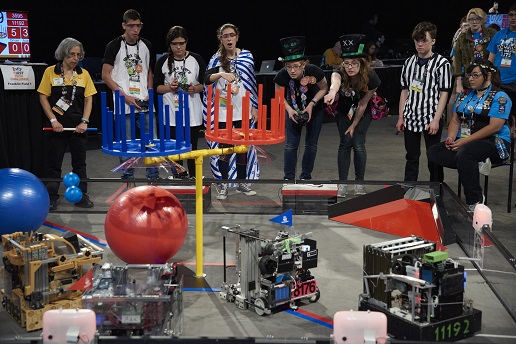-
Notifications
You must be signed in to change notification settings - Fork 1
The FTC Control System
The FIRST Tech Challenge seeks to inspire youth to become the next generation of STEM leaders and innovators through participation in mentor-guided robotics competition. Teams who participate in the FIRST Tech Challenge must build a robot that performs a variety of tasks. The tasks vary from season to season, and are based on a set of game rules that are published at the start of each season. The more tasks that a robot can complete, the more points a team will earn.

(Photo courtesy of Dan Donovan, ©2017 Dan Donovan / www.dandonovan.com)
A FIRST Tech Challenge match has an autonomous phase and a driver-controlled or "tele-operated" phase. In the autonomous phase of a match the robot operates without any human input or control. In the driver-controlled phase, the robot can receive input from up to two human drivers.
The FIRST Tech Challenge uses Android devices to control its robots. During a competition, each team has two Android devices.

One Android device is mounted onto the robot and is called the Robot Controller. The Robot Controller acts as the “brains” of the robot. It does all of the thinking for the robot and tells the robot what to do. It consists of an Android device running an FTC Robot Controller app. There are two hardware options currently being used: REV Robotics Expansion Hub or the REV Robotics Control Hub.
A second Android device sits with the team drivers and has one or two gamepads connected. This second device is known as the Driver Station. The Driver Station is sort of like a remote control that you might use to control your television. The Driver Station allows a team to communicate remotely (using a secure, wireless connection) to the Robot Controller and to issue commands to the Robot Controller. The Driver Station consists of an Android device running an FTC Driver Station app.
The REV Robotics Expansion Hub is the electronic input/output (or “I/O”) module that lets the Robot Controller talk to the robot’s motors, servos, and sensors. The Robot Controller communicates with the Expansion Hub through a serial connection. For the situation where an Android smartphone is used as the Robot Controller, a USB cable is used to establish the serial connection. For the situation where a REV Robotics Control Hub is used, an internal serial connection exists between the built-in Android device and the Expansion Hub.
The Expansion Hub is also connected to a 12V battery which is used to power the Expansion Hub, the motors, the servos and sensors. If an Android smartphone is used as the Robot Controller, then the smartphone will have its own independent battery. If a REV Robotics Control Hub is used as the Robot Controller, then the Control Hub will use the main 12V battery to power its internal Android device.

For the 2019-2020 season, teams in select regions will have the option of using the REV Robotics Control Hub. The Control Hub is an integrated version of the Robot Controller. It combines an Android device built into the same case as a REV Robotics Expansion Hub.

The Control Hub, which has its built-in Android device connected directly to the Expansion Hub using an internal serial bus, eliminates the need for an external USB connection between the Android Robot Controller and the I/O module.

During a typical FIRST Tech Challenge match, a team’s robot has to perform a variety of tasks in an effort to score points. For example, a team might want their robot to follow a white line on the competition floor and then score a game element (such as a ball) into a goal autonomously during a match. Teams write “op modes” (which stand for “operational modes”) to specify the behavior for their robot.
Op modes are computer programs that are used to customize the behavior of a competition robot. The Robot Controller can execute a selected op mode to perform certain tasks during a match.
Teams who are participating in the FIRST Tech Challenge have a variety of programming tools that they can use to create their own op modes. Teams can use a visual ("drag and drop") programming tool called the FTC Blocks Programming Tool to create their op modes. Teams can also use a text-based Java tool known as the FTC OnBot Java Programming Tool or Google's Android Studio integrated development environment (also known as an "IDE") to create their op modes.
